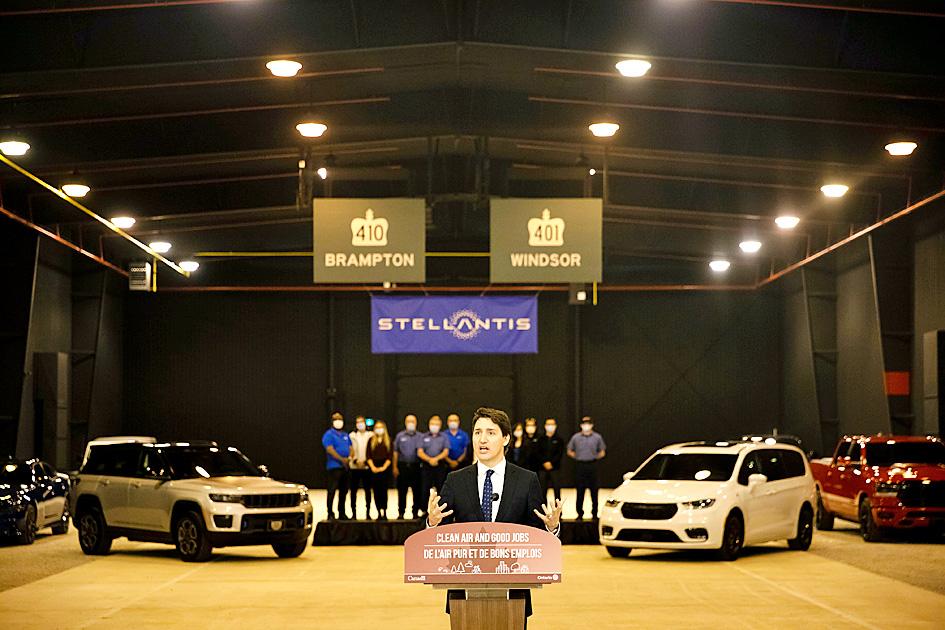Stellantis NV is to invest C$3.6 billion (US$2.8 billion) to retool two Canadian assembly plants to build electric vehicles (EVs), more than doubling an earlier commitment made during union negotiations.
Stellantis, formed from the merger of Fiat Chrysler Automobiles NV and PSA Group last year, is to add a new vehicle platform that can be used to make electric vehicles at its plants in Windsor and Brampton, Ontario, the company said in a statement on Monday.
The investments will restore employment at the two plants, which have suffered reductions in recent years.

Photo: Bloomberg
“These investments reaffirm our long-term commitment to Canada and represent an important step as we move toward zero-emission vehicles,” Stellantis North America chief operating officer Mark Stewart said in the statement.
Canadian Prime Minister Justin Trudeau, Ontario Premier Doug Ford and other Canadian officials attended an event in Windsor on Monday announcing the investment. Ford is expected to officially begin his campaign for re-election this week, with Canada’s most populous province going to the polls next month.
The federal government and the province of Ontario are to spend up to about C$1 billion to support the project.
The sprawling manufacturer of nameplates like Jeep, Ram and Fiat is investing US$35 billion globally through 2025 to beef up its electrification and software capabilities.
In March, Stellantis and LG Energy Solution said they would pour more than US$4.1 billion into a joint venture to build a new EV battery plant in Windsor. The 45 gigawatt-hour factory, which is expected to begin operations in 2025, are expected to create 2,500 jobs, and supply Stellantis’s assembly facility in Windsor and others across North America.
Windsor, which makes the Chrysler Pacifica minivan, is running on two shifts after cutting one-third in 2020. Its second shift is scheduled to be dropped at the end of this year.
The Brampton plant, which makes the Dodge Charger and Challenger muscle cars, would build at least one new all-electric model as part of the investment, the company said.
Both plants are expected to return to three shifts at a later date, the company said.
Meanwhile, Stellantis is to acquire the Share Now vehicle-sharing joint venture formed by BMW AG and Mercedes-Benz AG, a move aimed at tapping new revenue streams.
The company yesterday said its Free2Move mobility service brand would acquire Share Now, without naming a price.
Share Now, the European market leader, allows customers to use smartphones for short-term rentals of vehicles, including Minis or Mercedes-Benz A-Class vehicles in cities.
Free2Move offers app-based parking, leasing and rental services to its approximately 2 million customers.
Share Now provides so-called free-floating vehicle sharing services in 16 European cities and has about 3.4 million customers.
Over the next decade, Stellantis intends to expand Free2move’s presence worldwide, growing it to 15 million active users and achieving net revenues of 2.8 billion euros (US$2.94 billion).

Taiwanese suppliers to Taiwan Semiconductor Manufacturing Co. (TSMC, 台積電) are expected to follow the contract chipmaker’s step to invest in the US, but their relocation may be seven to eight years away, Minister of Economic Affairs J.W. Kuo (郭智輝) said yesterday. When asked by opposition Chinese Nationalist Party (KMT) Legislator Niu Hsu-ting (牛煦庭) in the legislature about growing concerns that TSMC’s huge investments in the US will prompt its suppliers to follow suit, Kuo said based on the chipmaker’s current limited production volume, it is unlikely to lead its supply chain to go there for now. “Unless TSMC completes its planned six

Power supply and electronic components maker Delta Electronics Inc (台達電) yesterday said second-quarter revenue is expected to surpass the first quarter, which rose 30 percent year-on-year to NT$118.92 billion (US$3.71 billion). Revenue this quarter is likely to grow, as US clients have front-loaded orders ahead of US President Donald Trump’s planned tariffs on Taiwanese goods, Delta chairman Ping Cheng (鄭平) said at an earnings conference in Taipei, referring to the 90-day pause in tariff implementation Trump announced on April 9. While situations in the third and fourth quarters remain unclear, “We will not halt our long-term deployments and do not plan to

‘SHORT TERM’: The local currency would likely remain strong in the near term, driven by anticipated US trade pressure, capital inflows and expectations of a US Fed rate cut The US dollar is expected to fall below NT$30 in the near term, as traders anticipate increased pressure from Washington for Taiwan to allow the New Taiwan dollar to appreciate, Cathay United Bank (國泰世華銀行) chief economist Lin Chi-chao (林啟超) said. Following a sharp drop in the greenback against the NT dollar on Friday, Lin told the Central News Agency that the local currency is likely to remain strong in the short term, driven in part by market psychology surrounding anticipated US policy pressure. On Friday, the US dollar fell NT$0.953, or 3.07 percent, closing at NT$31.064 — its lowest level since Jan.

The New Taiwan dollar and Taiwanese stocks surged on signs that trade tensions between the world’s top two economies might start easing and as US tech earnings boosted the outlook of the nation’s semiconductor exports. The NT dollar strengthened as much as 3.8 percent versus the US dollar to 30.815, the biggest intraday gain since January 2011, closing at NT$31.064. The benchmark TAIEX jumped 2.73 percent to outperform the region’s equity gauges. Outlook for global trade improved after China said it is assessing possible trade talks with the US, providing a boost for the nation’s currency and shares. As the NT dollar